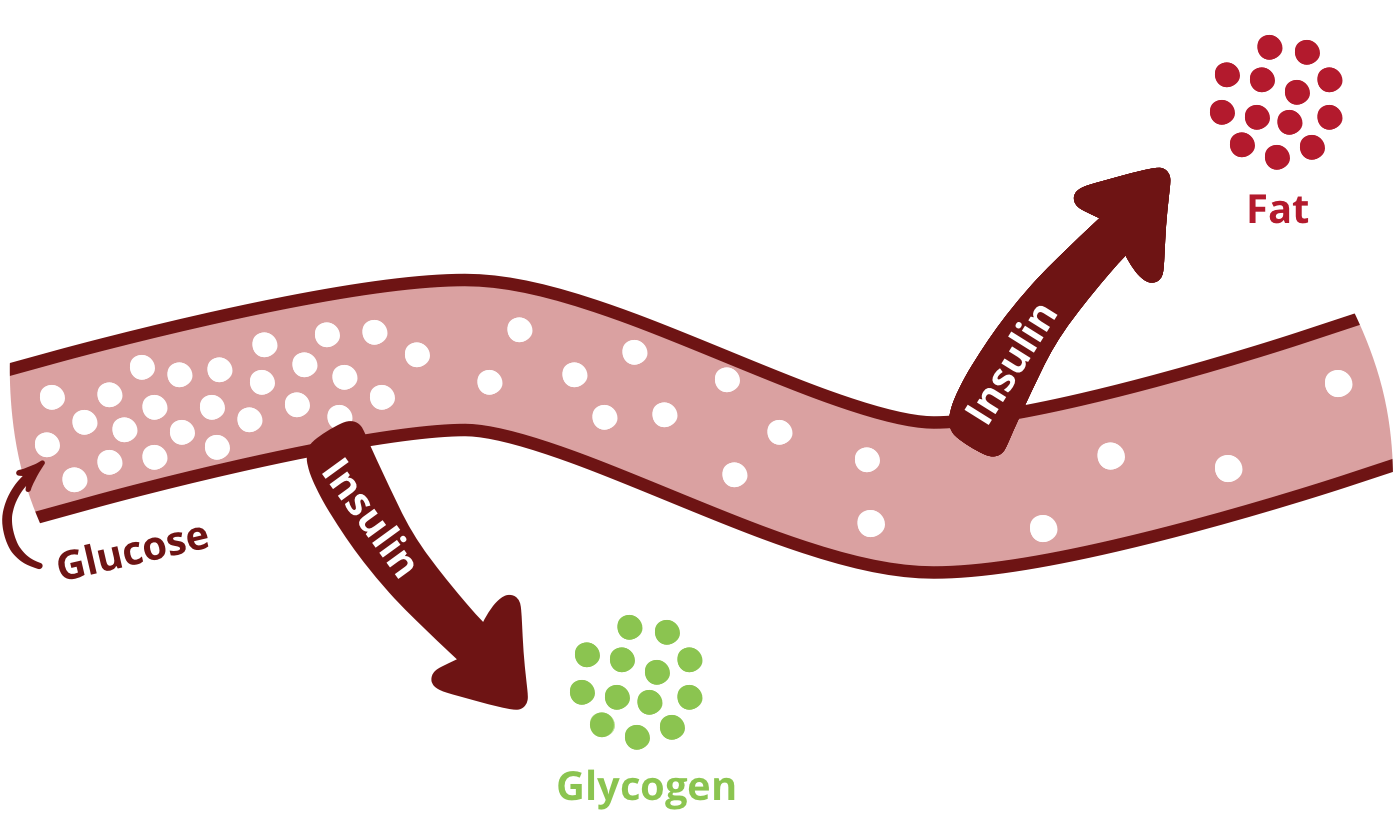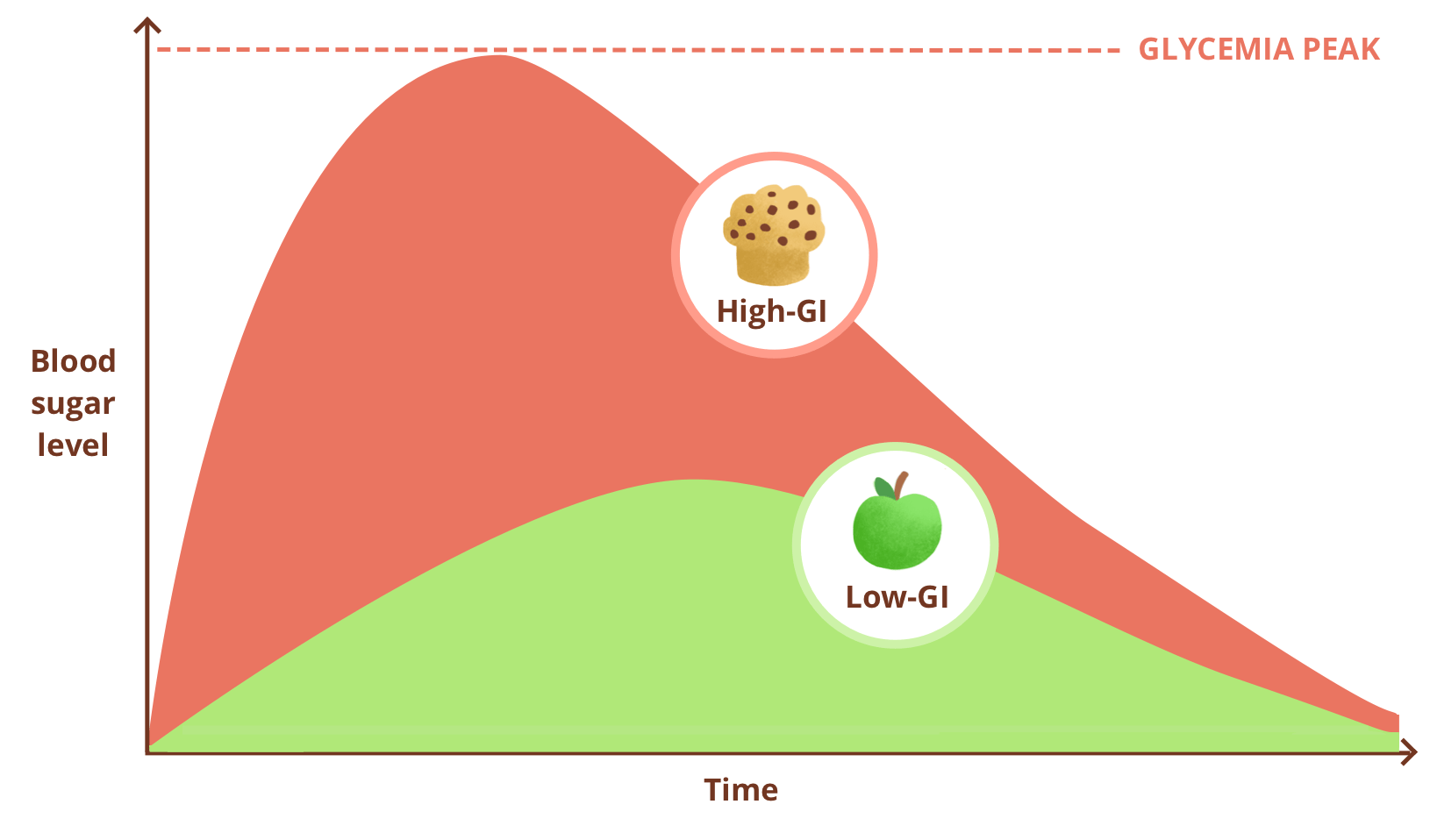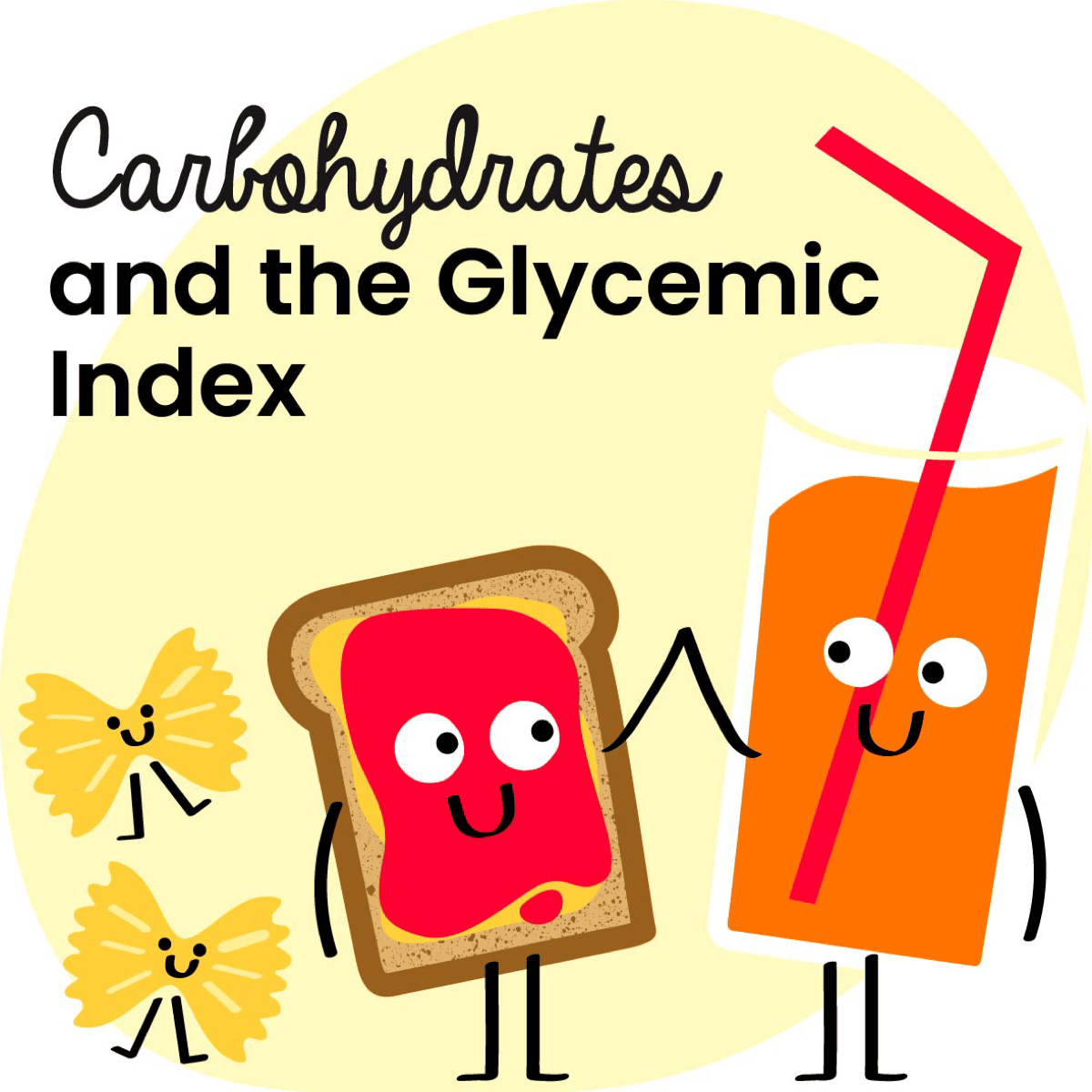Carbohydrates are also known as “carbs” or sugars. They work like fuel: their main function is to deliver energy to cells in our body, which we call “calories”.
Simple and complex carbohydrates
Carbohydrates are usually divided into two groups:
- Simple carbohydrates:
- These are made up of tiny molecules
- and generally have a sweet flavor.
- They are found in granulated sugar, honey, fruits, cookies and sweet snacks that often contain lots of added sugar. The lactose (or milk sugar) found in dairy products is also a simple carbohydrate.
- Complex carbohydrates:
- They are made up of larger, more complex molecules.
- Their flavor is not sweet.
- They occur mainly as starch and fiber in bread, pasta, potatoes, grains (rice, wheat, quinoa, corn, etc.) and legumes (lentils, chickpeas, beans, etc.).
What is the glycemic index used for?
We often hear that simple carbohydrates are fast carbs and that complex carbohydrates are slow carbs. Unfortunately, it is not that simple. The glycemic index (GI) is what tells us whether a carb is “slow” or “fast”.
The glycemic index allows us to compare a food’s ability to raise blood sugar (glucose) levels. It indicates the speed at which the glucose from a given food makes its way into the blood. The higher the glycemic index, the faster the amount of sugar in the blood will increase after the food has been absorbed.
When a lot of sugar enters the body, the pancreas will secrete insulin, the hormone whose role is to regulate the amount of sugar in the blood. The higher a food’s glycemic index, the more insulin is released. The insulin will then convert the glucose and store it as glycogen so that it can be used later as an energy source for the body’s muscles, the heart and the brain.

But we have a limited capacity for glycogen storage. When our glycogen stores are full, the insulin will transform the excess glucose into…fat! This fat will be stored in our fatty tissues, which are the body’s fat deposits under the skin.
What are examples of glycemic index scores?
Here are some reference points to help you identify the glycemic index of different foods. Generally speaking, simple carbohydrates have a medium to high glycemic index and cause blood glucose to rise quickly. It varies for complex carbohydrates.
- Low-GI foods: legumes (lentils, peas, chickpeas), nuts (walnuts, peanuts), some fruits (apples, pears, bananas, oranges, kiwis, grapes), some grains (multigrain bread, bulgur, brown rice, plain muesli), dark chocolate
- Medium-GI foods: whole-grain pasta, some fruits (raisins, pineapple, cherries, melon), white rice, whole wheat bread, milk chocolate, jam
- High-GI foods: potatoes, white bread, thoroughly cooked pasta, rice cakes, candy, dried fruits (dates, dried apricots, raisins, etc.), honey
Factors that influence glycemic index
There are variables that can affect the glycemic index of a food:
 | 1) Doneness: The more cooked a food is, the higher its GI. The GI for al dente pasta is lower than the GI for thoroughly cooked pasta, for example, and the GI for potatoes is lower when they are steamed versus when they are baked. |
 | 2) Fiber content: Fiber lowers a food's GI. Brown rice and whole wheat bread have a lower GI than white rice and white bread because they have more fiber. Along the same lines, a fruit will have a lower glycemic index than a fruit juice because the juice has no fiber. |
 | 3) Processing The more processed a food is, the higher its GI. Oatmeal, for example, has a GI of about 60, but puffed grains, which have been cooked and exposed to high pressure, have a GI about about 80. And, logically, cooked vegetables that are pureed into a soup have a higher GI than raw veggies. |
 | 4) Food combinations The presence of fat and protein in a meal lowers the speed at which carbohydrates are absorbed and, therefore, the glycemic index for the meal. |
Our diets have too many carbohydrates
Cookies, white bread, pasta, rice, crisp bread… these days we eat far too many carbs, especially carbohydrates with a high glycemic index. This translates into several problems:
Weight gain
As discussed above, the body has limited capacity to store glucose in the form of glycogen. When there is no more room, insulin will transform the excess glucose into fat.
That means that eating too many high-GI foods leads to weight gain and even obesity.
Stress and fatigue
Eating foods with a high glycemic index causes spikes in blood glucose: the amount of sugar in the blood climbs quickly and significantly.The body responds by secreting lots of insulin to bring down the blood sugar level. Then the amount of sugar in the blood takes a nosedive.

This sudden drop triggers fatigue, which explains the “slump” we feel after a meal that was loaded with fast carbs. The repetition of these blood glucose spikes can cause chronic fatigue and reduced alertness on a daily basis.
Furthermore, ongoing fluctuations in blood glucose over the course of a day also cause stress, which has become a common problem in recent years.
Increased insulin resistance and risk of diabetes
Excessive carbohydrate consumption also causes the body to develop insulin resistance over the long term. When they are overstimulated by insulin, our cells eventually develop a kind of resistance and sometimes stop responding to insulin the way they are supposed to.
Meanwhile, the cells of the pancreas, depleted from massive insulin production, will secrete less and less insulin.
These hormonal disorders surrounding insulin are the primary cause of type 2 diabetes. They also raise the risk of cardiovascular disease and chronic inflammation.
What you can do
Here are some practical steps you can take to promote stable blood glucose:
 | 1) Choose low-GI carbohydrates:prioritize raw and minimally processed foods such as whole grains, semi-hulled grains and legumes. |
 | 2) Consume whole fruits rather than fruit juices, which have been stripped of their fiber and have higher GIs. |
 | 3) Pair as many meals as possible with veggies rather than grains: vegetables should take up at least half of your plate. |
 | 4) Pick fiber-rich foods that will slow down the speed of glucose uptake. |
 | 5) Opt for whole-wheat sourdough bread instead of white bread, which has far less fiber. |
 | 6) Eat protein at breakfast and lunch: it will also slow down the assimilation of glucose. |
- Atkinson FS, Foster-Powell K, Brand-Miller JC. International tables of glycemic index and glycemic load values: 2008. Diabetes Care. 2008;31(12):2281–2283. doi:10.2337/dc08-1239
- Adedayo BC, Adebayo AA, Nwanna EE, Oboh G. Effect of cooking on glycemic index, antioxidant activities, α-amylase, and α-glucosidase inhibitory properties of two rice varieties. Food Sci Nutr. 2018;6(8):2301–2307. Published 2018 Oct 11. doi:10.1002/fsn3.806
- Wolever TM. Effect of macronutrients on the glycemic index. Am J Clin Nutr. 2017;106(2):704–705. doi:10.3945/ajcn.117.158055
- Breymeyer KL, Lampe JW, McGregor BA, Neuhouser ML. Subjective mood and energy levels of healthy weight and overweight/obese healthy adults on high-and low-glycemic load experimental diets. Appetite. 2016;107:253–259. doi:10.1016/j.appet.2016.08.008
- Cui H, Yang Y, Bian L, He M. [Effect of food composition of mixed food on glycemic index]. Wei Sheng Yan Jiu. 1999 Nov;28(6):356-8. Chinese. PubMed PMID: 12016989.
- Haghighatdoost F, Azadbakht L, Keshteli AH, Feinle-Bisset C, Daghaghzadeh H, Afshar H, Feizi A, Esmaillzadeh A, Adibi P. Glycemic index, glycemic load, and common psychological disorders. Am J Clin Nutr. 2016 Jan;103(1):201-9. doi: 10.3945/ajcn.114.105445. Epub 2015 Nov 25. PubMed PMID: 26607943.
- Radulian G, Rusu E, Dragomir A, Posea M. Metabolic effects of low glycaemic index diets. Nutr J. 2009;8:5. Published 2009 Jan 29. doi:10.1186/1475-2891-8-5
- Brand-Miller JC, Holt SH, Pawlak DB, McMillan J. Glycemic index and obesity. Am J Clin Nutr. 2002 Jul;76(1):281S-5S. Review. PubMed PMID: 12081852.
- Rouhani MH, Kelishadi R, Hashemipour M, Esmaillzadeh A, Azadbakht L. The effect of low glycemic index diet on body weight status and blood pressure in overweight adolescent girls: a randomized clinical trial. Nutr Res Pract. 2013;7(5):385–392. doi:10.4162/nrp.2013.7.5.385
- Zafar MI, Mills KE, Zheng J, Peng MM, Ye X, Chen LL. Low glycaemic index diets as an intervention for obesity: a systematic review and meta-analysis. Obes Rev. 2019 Feb;20(2):290-315. doi: 10.1111/obr.12791. Epub 2018 Nov 20. PubMed PMID: 30460737.
- Bell SJ, Sears B. Low-glycemic-load diets: impact on obesity and chronic diseases. Crit Rev Food Sci Nutr. 2003;43(4):357-77. Review. PubMed PMID: 12940416.
- Vega-López S, Venn BJ, Slavin JL. Relevance of the Glycemic Index and Glycemic Load for Body Weight, Diabetes, and Cardiovascular Disease. Nutrients. 2018;10(10):1361. Published 2018 Sep 22. doi:10.3390/nu10101361
- Vega-López S, Mayol-Kreiser SN. Use of the glycemic index for weight loss and glycemic control: a review of recent evidence. Curr Diab Rep. 2009 Oct;9(5):379-88. Review. PubMed PMID: 19793508.
- https://www.ameli.fr/assure/sante/themes/diabete-comprendre/definition
- Eleazu CO. The concept of low glycemic index and glycemic load foods as panacea for type 2 diabetes mellitus; prospects, challenges and solutions. Afr Health Sci. 2016;16(2):468–479. doi:10.4314/ahs.v16i2.15
- Sacks FM, Carey VJ, Anderson CA, et al. Effects of high vs low glycemic index of dietary carbohydrate on cardiovascular disease risk factors and insulin sensitivity: the OmniCarb randomized clinical trial. JAMA. 2014;312(23):2531–2541. doi:10.1001/jama.2014.16658
- Willett W, Manson J, Liu S. Glycemic index, glycemic load, and risk of type 2 diabetes. Am J Clin Nutr. 2002 Jul;76(1):274S-80S. Review. PubMed PMID: 12081851.
- Bhupathiraju SN, Tobias DK, Malik VS, et al. Glycemic index, glycemic load, and risk of type 2 diabetes: results from 3 large US cohorts and an updated meta-analysis. Am J Clin Nutr. 2014;100(1):218–232. doi:10.3945/ajcn.113.079533
- Ojo O, Ojo OO, Adebowale F, Wang XH. The Effect of Dietary Glycaemic Index on Glycaemia in Patients with Type 2 Diabetes: A Systematic Review and Meta-Analysis of Randomized Controlled Trials. Nutrients. 2018;10(3):373. Published 2018 Mar 19. doi:10.3390/nu10030373





